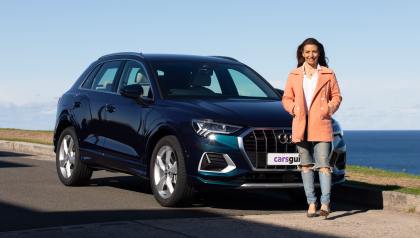Is the Mercedes-Benz GLA 250 4Matic a good urban car?
Seems like it should be. After all, besides being a small SUV from a luxury brand, the German five-seater crossover is also the latest incarnation of the GLA – the second-generation version that only arrived in 2020.
Well, my little family and I live in an apartment in Sydney close to the CBD and the GLA 250 4Matic (Mercedes-speak for all-wheel drive, or AWD) came to stay for a week. We used it probably how you would, too, and we found out what’s good, what could be better and what we actually didn’t need.
Mercedes-Benz GLA 2021: 250 4Matic
| Engine Type | Turbo 4, 2.0L |
|---|---|
| Fuel Type | Premium Unleaded Petrol |
| Fuel Efficiency | 7.5L/100km (combined) |
| Seating | 5 |
| Price From | $61,930 - $71,170 |
Is there anything interesting about its design?
The latest GLA is much better looking than the old one. Yep, the previous model looked more like a hatchback with an elevated ride height, but this new iteration properly looks like a part of Mercedes-Benz’s SUV family.
That’s because it’s taller at 1611mm high, although shorter at 4410mm end to end and wider at 1834mm across. So, it has more traditional SUV proportions with its taller, boxier shape, although it’s still svelte and smooth looking, much like the bigger GLC.
.jpg)
The recently-released GLB, meanwhile, sits between the GLA and GLC, and if you like boxy, then be sure to take a look at that. But smaller suits a city better in many cases, such as parking and piloting narrow streets, and the GLA is the littlest SUV Mercedes-Benz currently offers in Australia.
While the GLA might be small though, it is prestigious and modern looking, especially our GLA 250, which was fitted with several option packs, which enhance the look. More on those a little later.
.jpg)
The glamour isn't just contained to the newcomer's exterior, either, with a pair of 10.25-inch screens stretching across the dash. The stunning cabin in our test car was also boosted by a number of packages/options, which lift it even higher. Much higher.
How much does all this cost? Yes, about that – we’re almost there.
Does it represent good value for the price? What features does it come with?
The GLA 250 4Matic lists for $66,500, which is about $10K more than the base grade GLA 200.
Now, that base variant is pretty well specified, featuring a proximity key, electric tailgate, those two large 10.25-inch screens, sat nav, Apple CarPlay and Android Auto connectivity, alternate drive modes, 64-colour ambient lighting, digital radio, auto parking, LED headlights with adaptive high beams, 19-inch alloys and a racy chrome-studded grille.
The GLA 250 adds a sunroof, heated front seats and remote engine start, along with significant mechanical differences, including AWD, a larger and substantially more powerful engine, sports suspension and an Off-road Engineering package, which I’ll tell you about in the engine specs section.
.jpg)
As mentioned earlier, our GLA 250 also included optional extras, starting with a $2838 AMG Exclusive Package, which adds the Titan Grey Peal/Black Lugano leather upholstery as seen in the images, as well as a $915 Vision Package, bringing adaptive LED headlights, a panoramic sunroof, and 360-degree camera.
The Sports Package at $1915 ushers in unique 19-inch alloy wheels, black roof rails, privacy glass, an AMG body kit, AMG brake callipers (with Mercedes-Benz lettering), leather sports steering wheel with paddle shifters, carbon trim and AMG floor mats, among other equipment.
The most expensive option on our GLA was the Innovations package, which costs $3490 and includes: augmented video; a Burmester sound system and a head-up display.
All these packages aren’t vital, as the GLA 250 comes with so much already, and the standard Artico upholstery feels and looks good, but from an urban perspective it’s hard to go past the Innovations Package, as its head-up display helps keep eyes on the road as well as your speed.
.jpg)

What are the key stats for the engine and transmission?
The main point of buying the GLA 250 4Matic over the GLA 200 is not for the sunroof nor heated seats the second-tier grade brings, but for the engine and AWD.
The GLA 250 delivers a 165kW/350Nm 2.0-litre four-cylinder turbo-petrol engine, driving all four wheels via an eight-speed dual-clutch automatic transmission (DCT), while the GLA 200 makes do with a 120kW/250Nm 1.3-litre petrol, seven-speed DCT and front-wheel drive (FWD).
.jpg)
The GLA 250 also comes standard with sports suspension which is lowered, while that Off-Road Engineering package features a drive setting for tougher terrains (keep in mind it’s not a bush-bashing 4x4 though) and a downhill driving function, plus a headlight trick that broadens the beam for better visibility during slow-speed driving. Neither are mandatory for urban duties.
You could also argue the same for AWD. So, while I enjoyed the responsiveness of the GLA 250 engine and sporty handling, the smaller engine in the GLA 200 and FWD is all you really need in an urban-only car.
How much fuel does it consume?
Stop go, stop, go, stop. That’s urban driving and it can mean way more petrol consumption than driving on motorways and country roads. The GLA 250 has an idle/stop fuel saving system which cuts the engine when you’re sitting in traffic, but the 2.0-litre engine and AWD system can certainly add to the thirst.
Mercedes-Benz says that its urban fuel consumption is 9.7L/100km. My own testing found the GLA 250 used 13.7L/100km when measured at the petrol pump. To be clear this after a week of urban-only driving.
If you were to regularly spend time on the motorway that fuel economy would be better, and Mercedes-Benz says that after a combination of open and urban roads the GLA 250 should use 7.5L/100km.
What's it like to drive around town?
Our place is about 8km from the CBD. The roads are barely holding together. Some of the streets are so narrow that it’s an instant stand off if you meet another car coming the other way and parking is scarce and even if you do jag a space it’s small.
Luckily the GLA 250 4MATIC is small too, with auto parking – big urban driving points there and it also proved easy to drive with good steering and great visibility.
.jpg)
The GLA 250’s engine was responsive with plenty of oomph and the dual clutch auto transmission performed smoothly in traffic.
That standard sports suspension is standard, and on the roads around me, the more cushioning you can have between you and the pothole the better, so the ride felt firm at times.
As with many Mercedes-Benz vehicles, the gear shifter is located on the steering column and is a similar design to an indicator stalk. It’s a personal thing but I think the design is great and not only can you keep both hands on the wheel while shifting, but it’s quicker for three-point turns.
.jpg)
Warranty & Safety Rating
What safety equipment is fitted? What safety rating?
The GLA is yet to be given an ANCAP safety rating, but it’s well specified with tech such as Autonomous Emergency Braking (AEB), which at city speeds can stop for parked cars and pedestrians. That’s a standard feature, as are a blind spot warning and active lane-keeping assistance.
The Exit Warning Assistant was given a workout daily, beeping and flashing at me through the blind spot warning icon in the wing mirrors, to alert me of approaching bikes and cars when opening the driver’s door to get out. That’s a great feature in the city too, with food-delivery bikes almost always looming perilously close.
.jpg)
Coming standard, as well, are nine airbags, traffic sign recognition and an active bonnet to lessen to impact on pedestrians (hopefully it doesn’t come to that) and Cross Wind Assist (to keep the GLA from swaying at speed).
More advanced technologies such as active lane-changing assistance and even a semi-autonomous driving feature for traffic jams are available in the optional Driving Assistance package.
How practical is the space inside?
The GLA is the SUV version of the Mercedes A-Class, and if you’re looking for a small family car then trust me when I say it’s far more practical than an A-Class hatch or the CLA sedan.
Legroom in the second row is good and, at 191cm tall, I can sit behind my driving position with space to spare. Headroom is also good back there.
The boot’s cargo capacity is 435 litres (VDA) which isn’t enormous for the class, but the load lip is low, and the tailgate is powered.
Cabin storage is good, with large door pockets, a deep centre console box, and two cup holders up front. Rear seat passengers don’t get cup holders – which will disappoint parents – as will the rear doors which don’t seem to open wide enough. At least directional air vents are fitted in the back.
There are also four mini USB ports on board (two in the rear and two up front).
.jpg)
What does it cost to own? What warranty is offered?
Mercedes-Benz covers the GLA with a five-year/unlimited kilometre warranty – a rarity among luxury brands.
Servicing is recommended at 12 month/25,000km intervals. There’s a three-year service plan for $2050 or if you decided to pay as you go servicing is capped at $550 for the first, $750 for the second and $1250 for the third.
.jpg)
Verdict
The GLA 250 4Matic’s small size, advanced safety tech and decent practicality are great for urban adventures. I’m a fan of its engine, the dual-clutch auto and all-wheel drive, plus the off-road pack which comes with this grade, and while this makes it a great daily driver, it’s not perfectly suited to urban driving.
If your A-to-B journeys are always going to be within an urban environment, you’d be better off with the front-wheel drive GLA 200 with a smaller engine and better fuel economy. You’ll save $10K straight up on the list price too and get most of the GLA 250’s features.
Pricing Guides




.jpg)
.jpg)
.jpg)
.jpg)
.jpg)
.jpg)

.jpg)
.jpg)
.jpg)
.jpg)
.jpg)
























.png)









.jpg)
.jpg)
.jpg)
.jpg)

1.jpg)
.jpg)

.jpg)


Comments